SPIDERS
-- PAGE 5 Orb Weavers (besides Nephilas)
This
page was born 09/13/2004. Rickubis designed it. (such as
it
is.) Last update: 06/09/2022
Images
and contents on this page copyright ©2002-2022 Richard M. Dashnau
spiders page 1 2 3 4 6 7 8
Go back to my home page, Welcome
to
rickubis.com
Go
back to the RICKUBISCAM
page.
Many of these
pictures were taken at Brazos Bend State Park. I hope that, like
me, the
next time you see a spider (and they are almost everywhere),
you'll take
a
second to admire their form and function...and leave them to
their hunting.
From BBSP on 05/01/2022
and -5/08/2022. The
morning air was thick with mist.Clouds overhead kept the
morning grey. I hoped that the water that I could feel
suspended
around me would be dried off when the sun broke
through. I hurried
toward 40-Acre Lake because I hoped to be at the lake trails
in time
for any choruses of alligator bellowing.
But when I got near the prairie I
saw something wonderful, and had to stop. Tiny water droplets
had
collected on the strands of hundreds of web structures which
almost
seemed to glow that
grey morning. While vertical orb webs
glistening with dew are beautiful; these were a bit different.
These were horizontal disks, enclosed in delicate
clusters of
tiny strands. I tried to take
photos, but I could not capture the scale of these hundreds of
clusters scattered across the field.




After
trying many angles of the prairie, I moved closer to show some
detail
of the webs. Although they were burdened by water droplets,
the centers
seemed to be structures like domes--
instead of cups collapsed by
the weight of the water. Tiny droplets on the strands
collected the
natural light into pinpoints. Within the nest of strands,
hanging
upside-down inside the domes,
were the dark shapes of spiders.




The
webs
were all on the prairie, not next to the trail, and I haven't
been
been happy with my macro photography in a long time...so I
stayed off
the field and shot from a few feet back.
I could focus on the
spiders inside, and also on the droplets. I moved on to see
the
alligators and, hopefully, Limpkins. Unfortunately the
gators
didn't chorus, and it started raining a few minutes
after I walked
to the trail where the Limpkins are. After the rain
stopped, I
walked out to examine the webs--but they were gone (perhaps
washed out
by the rain).




A
week later (05/08/2022), I took a closer, drier look at the
webs. There
were not as many this time. I took a few photos of one of the
webs and
the attractive owner. Once again, I was off to
look for alligator
behavior. Alligators are generally most active from sunrise to
about
11am-and that includes courtship season. That is why I moved
as though
I was keeping an appointment.
In a way, I was.




Judging
by
the size, shape, color--and the interesting horizontal stance,
I'd
thought these might Orchard Spiders (Leucauge venusta).
But
I'd
never noticed these interesting "dome" web
structures before.
Perhaps these were "nursery" webs that were made by young
spiders.
Orchard Spiders make orb webs that are horizontal (unlike most
common
orb-weavers which hang
their webs vertically), but I usually
notice only one flat orb. The pictures below are old photos
that I shot in
2002 and 2003. I was concentrating on getting the adult
spider,
so I didn't get much
detail of the webs. That is my finger in those images.
UPDATE
5/16/2022--Thanks
to
feedback from arachnology experts on Twitter (thanks so
far
to @tea_francis and @Cataranea) these are Basilica
Orbweavers (Mecynogea
lemniscata)
and not what I'd guessed as Orchard Spiders.
Now I have something else to share with folks on the
trail!




10/05/2002
10/12/2003
10/12/2003
11/16/2003
On
10/03/2021;
I caught sight of an orbweaver spider (redundant, but stated for
clarity) next to 40-Acre Lake. It was about 5 yards away on a
branch
hanging over the water,
and
illuminated by the morning sun-which highlighted the strands and
the
dewdrops upon them. However, the sight wasn't going to last,
because
the spider was packing up its web for
the day. Some
orbweavers create a web at night, and take it down in the
morning.
I've read that they usually eat the silk, so they can
re-use the
raw material for more
webbing. Spider silks are "...proteinaceous
and belong to the fibroins..." (Biology of Spiders third edition
by
Rainer F. Foelix page 136). Silk is manufactured in a
spider's
body
from various proteins, and production is dependent on a
spider's internal resources. Eating used silk seems like an
efficient
"short-cut" for producing more. I haven't seen this
happen very
often, and it is usually over quickly. So I shot video and hoped
for
the best. From what I can figure out, this spider is in the
Neoscona
genus. (maybe N. arabesca).
The images below are frame grabs from two video clips, which
I've edited into this very short film.
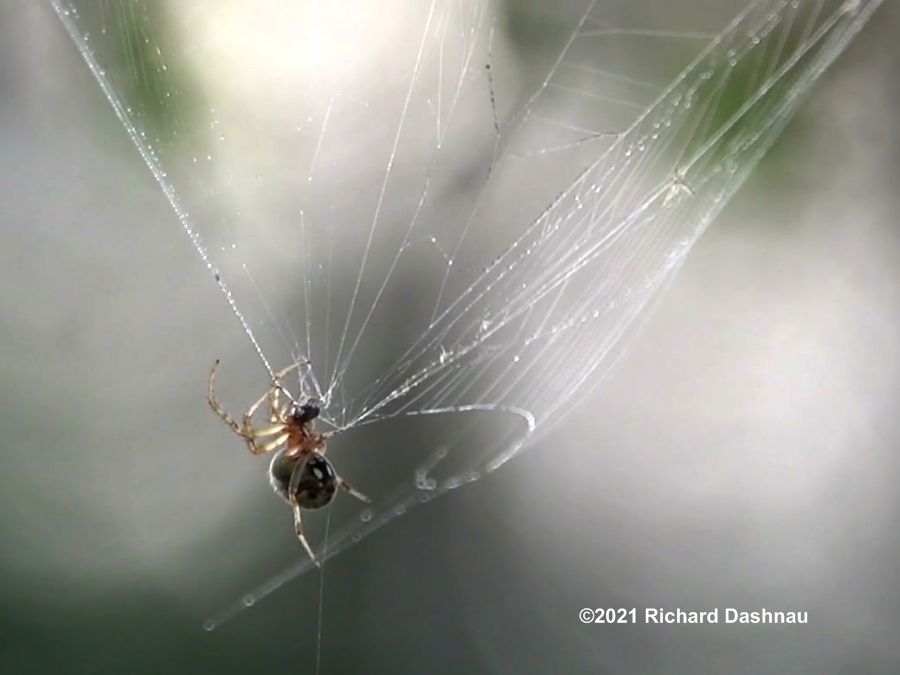
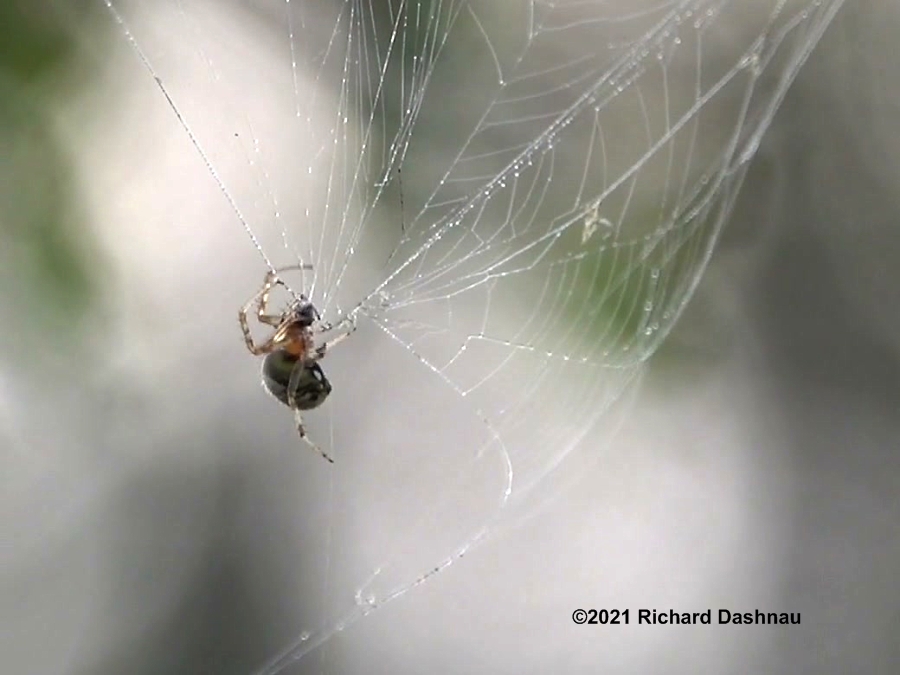
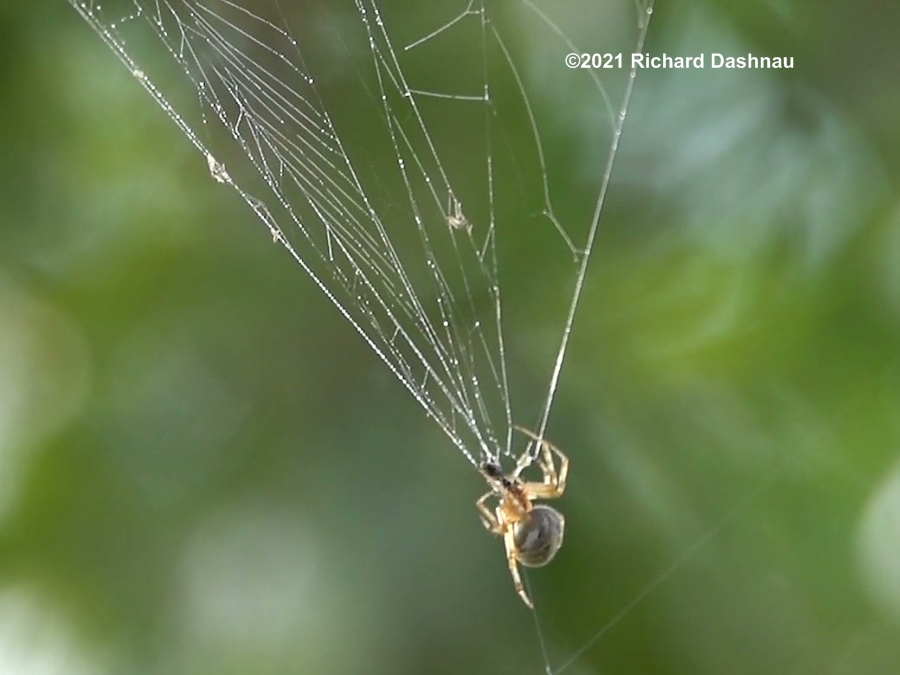
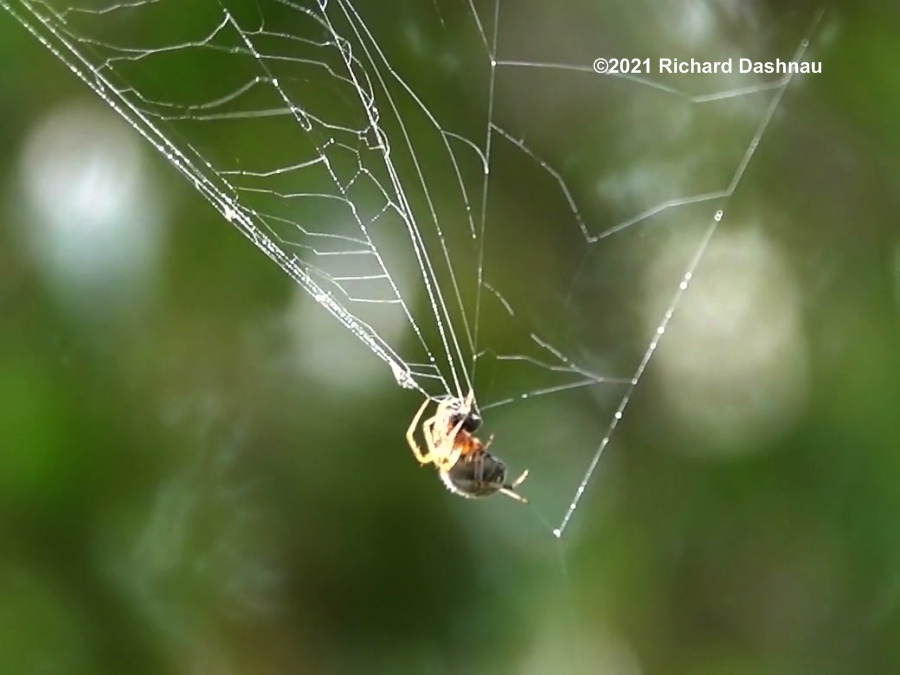
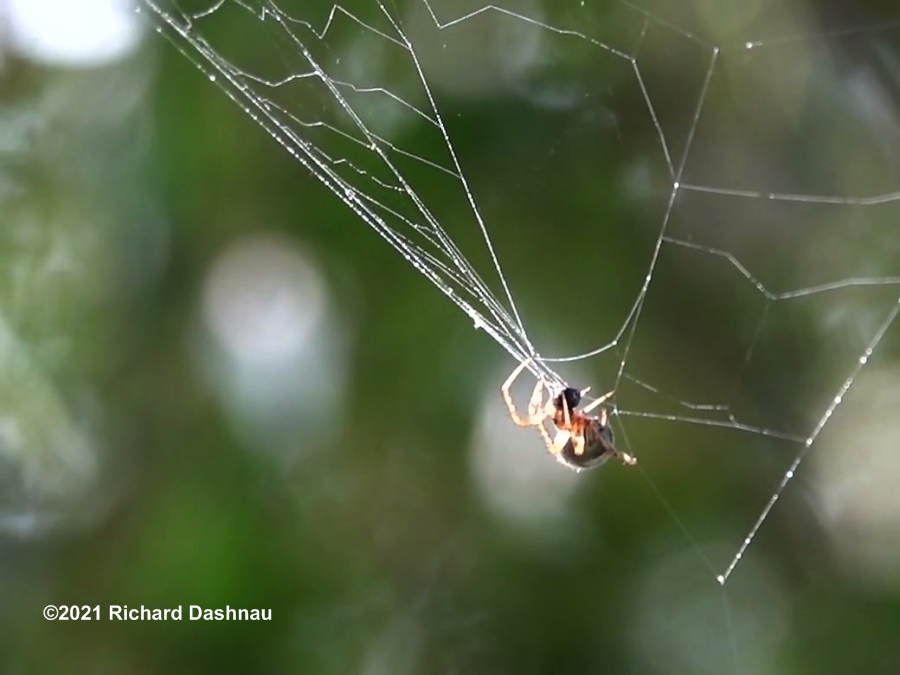
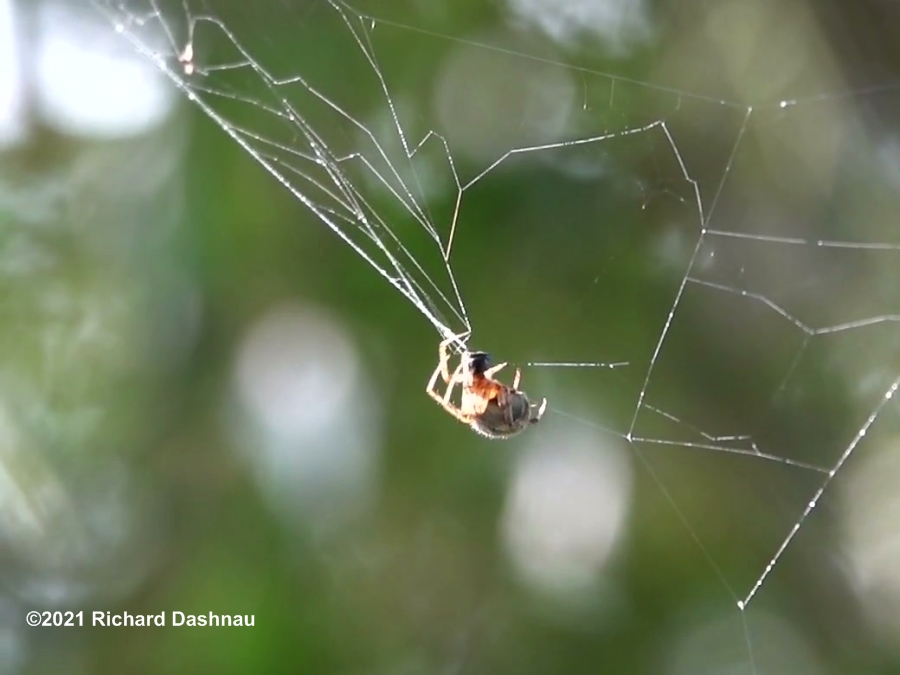
06/06;
06/12
and 06/13/2021
(posted 6/25/21) While going
down the steps from my apartment, I noticed some quick vibration
near my feet. It was a very
young spider, one of the Argiope genus I think, and it was vibrating its
web. Intimidating or
confusing potential predators are possible reasons for this behavior.
The young spider was also attached to
"mat" made of tightly zigzagged silk. This is
called a "stabilimentum", and in this case may also serve to disguise
the spider by
hiding its outline. The spider was
near the same spot the next day. It seemed to be a
bit larger. The stabilimentum in its web sure was! The spider left
and I never saw
it again. I have video showing the
young spider vibrating its web to hide. You
can compare with older example of an adult shaking its web (just below
in the page) and
see quite a difference. The
stabilimentum and the vibration can help disguise the spider to hide it.
But, from what? There may be an answer below. Most of the images
in
this chapter are frame grabs from various video clips that I
filmed that day. I've edited the clips together with some older ones
with wasps into this video (mp4).
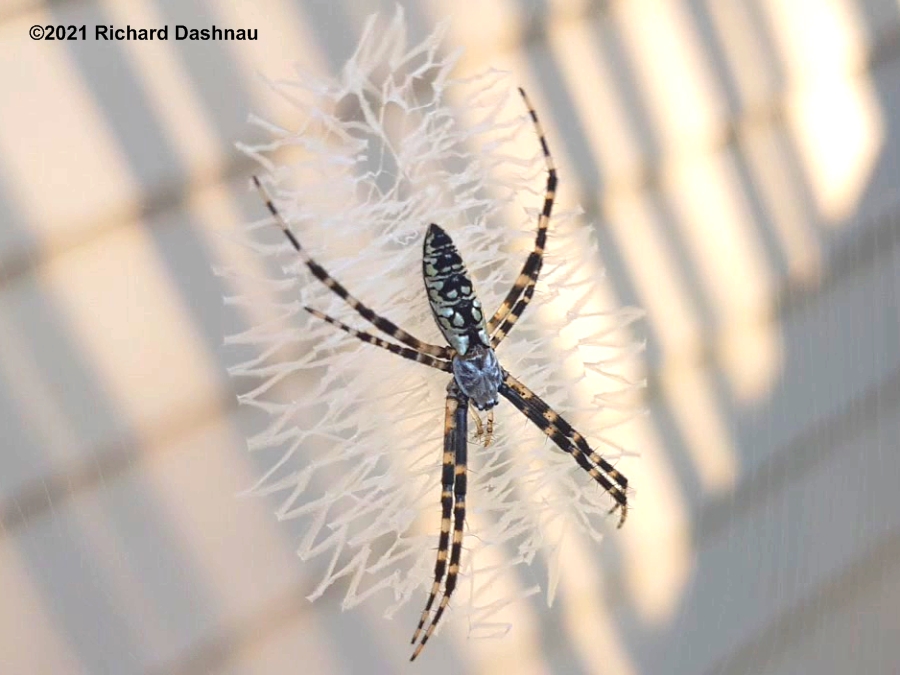
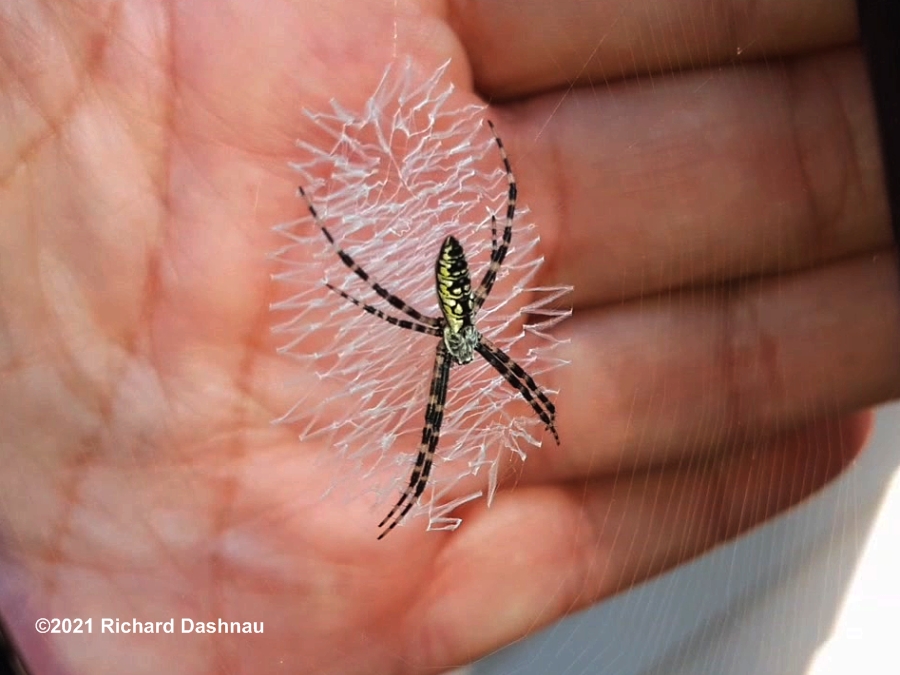
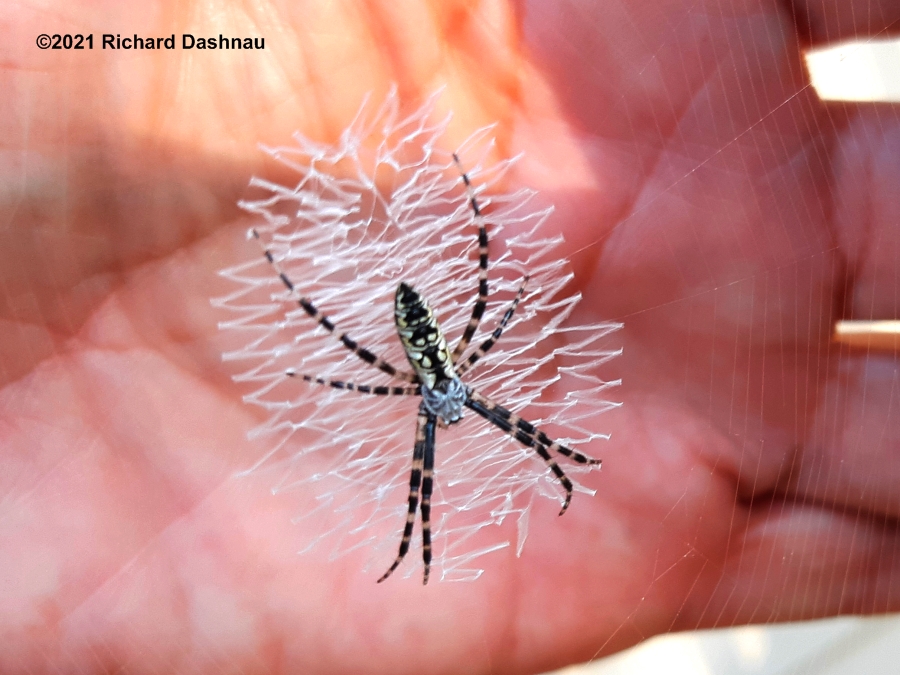
06/12/2021
06/12/2021
06/12/2021
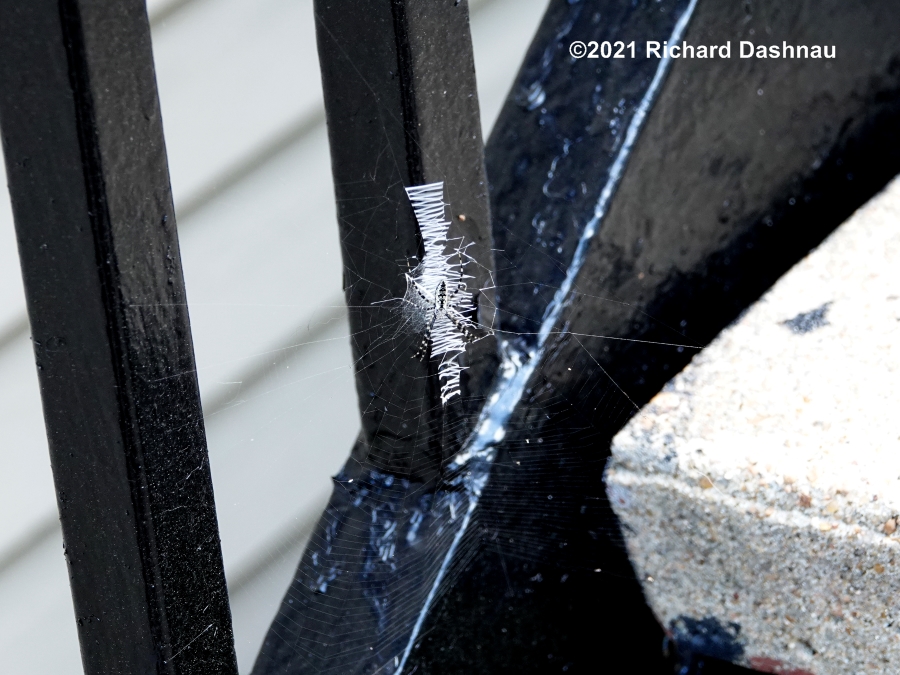
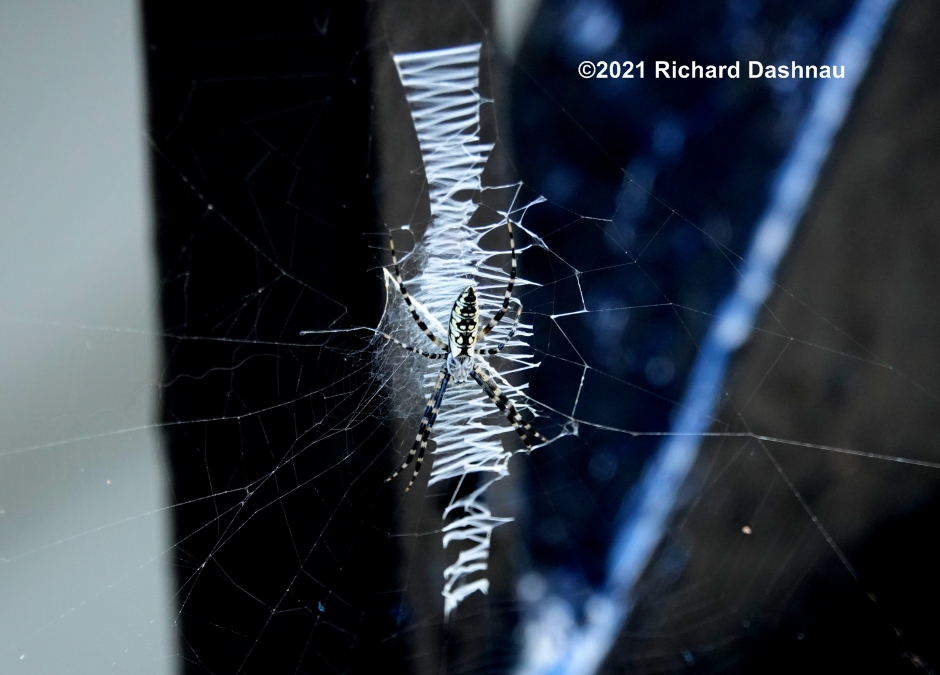
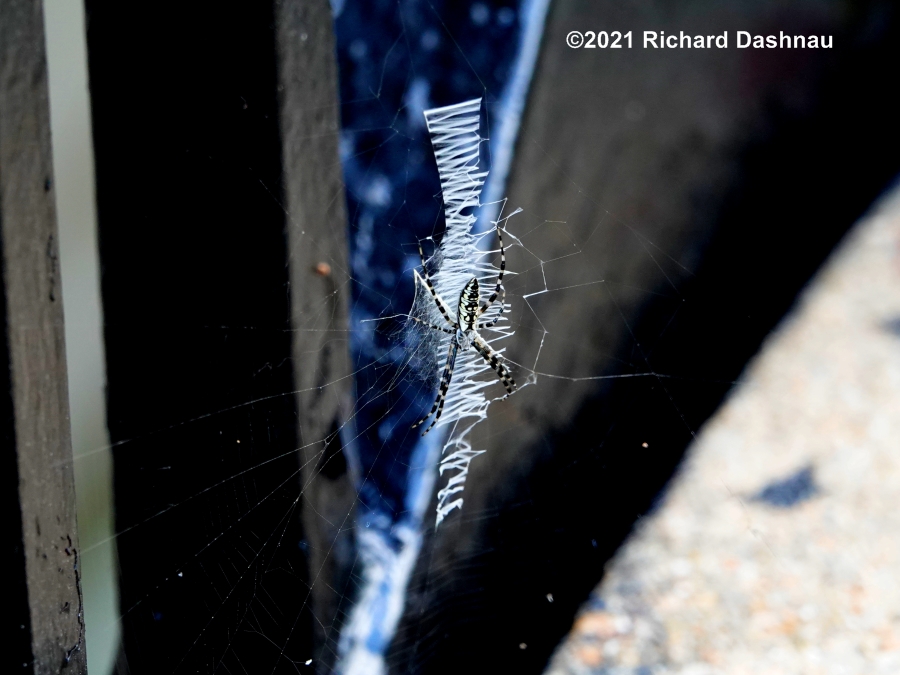
06/13/2021
06/13/2021
06/13/2021
September 12, 2010 Golden
Orb Weavers (Argiope aurantia) show an interesting behavior when
they
are disturbed on their web . The spider starts vibrating. That is,
it shakes the entire web by
shifting its body. When the spider
is small, it becomes a blur. When the spider is large (over
2
inch leg span) it's somewhat intimidating. Here's a video
I shot in 2010 that shows this behavior.
The
framegrab image below shows a spider just before it started
shaking.
The animated gif shows more of the frames from the video.
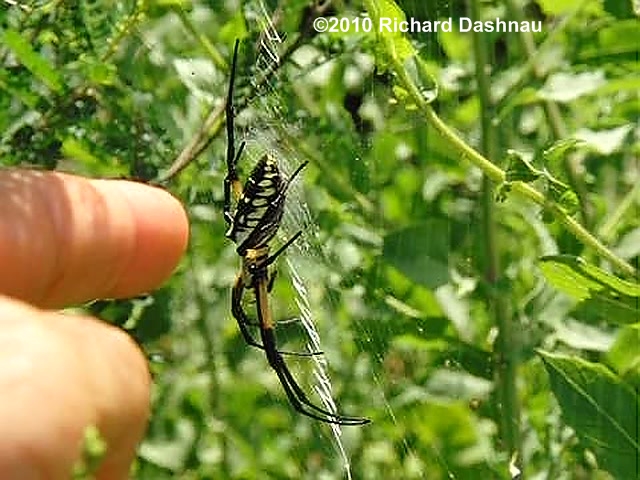
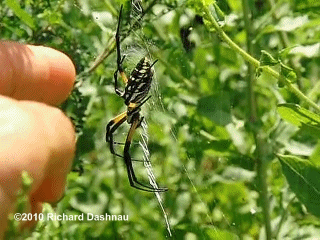
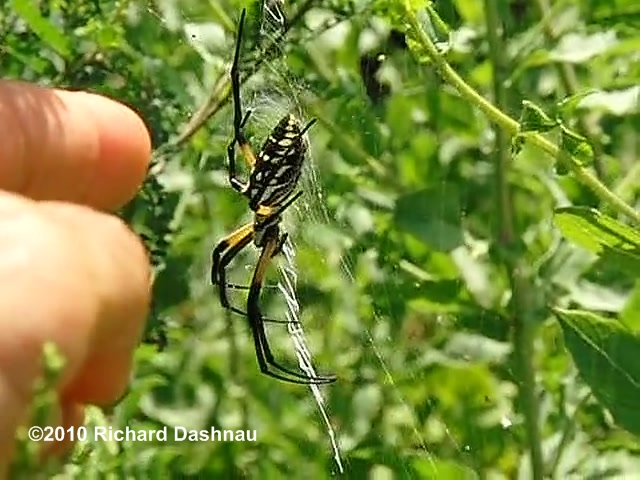
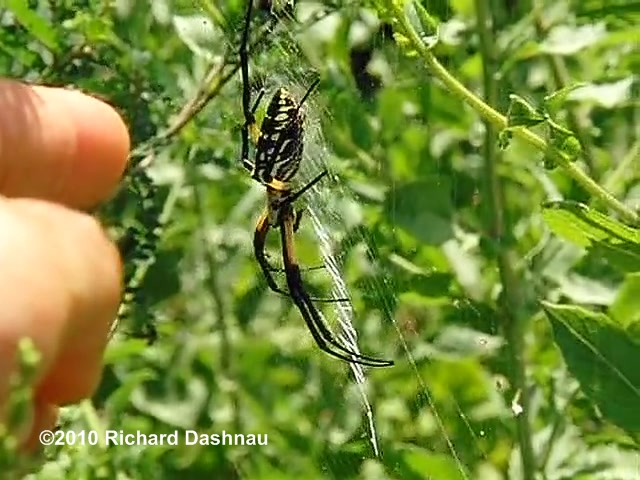
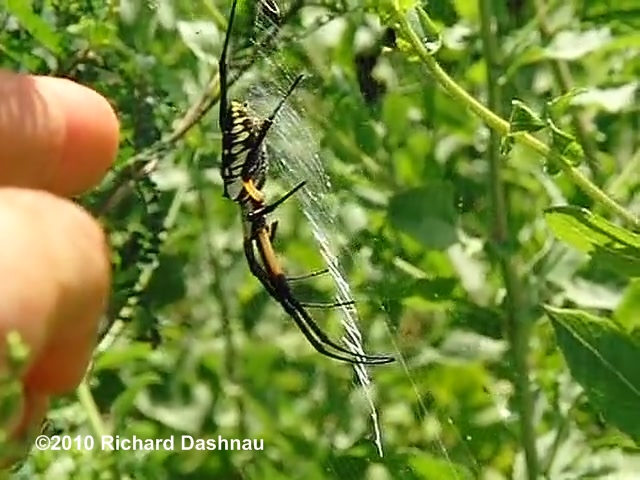
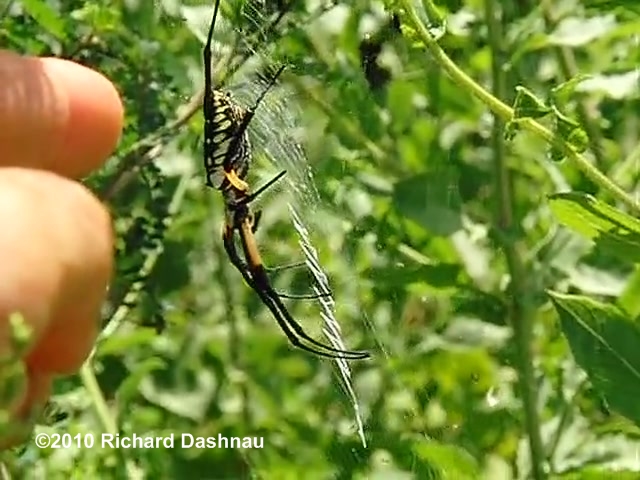
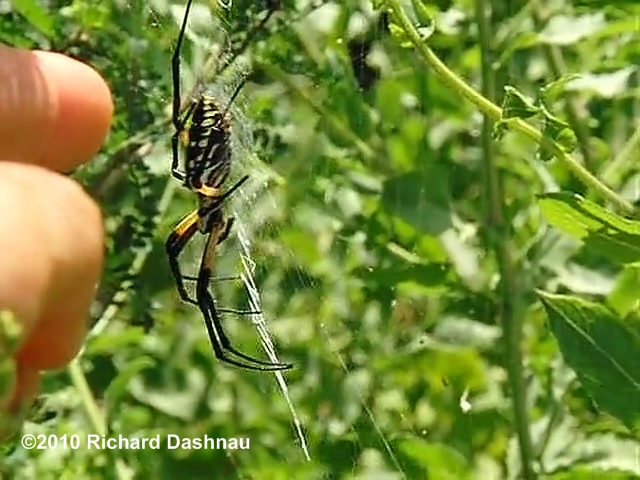
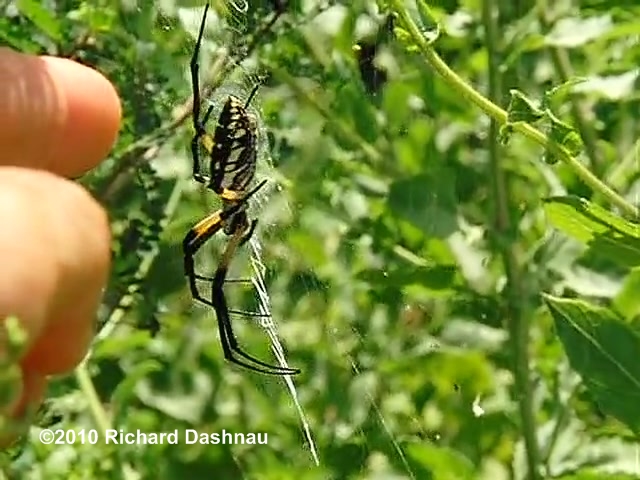
July
12, 2004I
guess it's time for a few more spider pictures. Back on June 6, I
encountered
a web on the Creekfield Trail with a huge beetle in it. There was
also
a large spider on the web,
which first ran off an hid in the leaves. After
just a few moments, it went back to feed on the beetle (see FROM
THE VIDEO,
below, or the video clip
464kb). The three images below show the
beetle and the spider (see
ONE'S A MEAL, below); a closeup of the spider (see GOOD EATIN',
below);
and a flash picture of the spider (FLASH ON THE SUBJECT, below) At
the
time, I was
unable to identify the spider.
---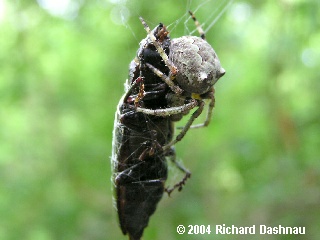 --
--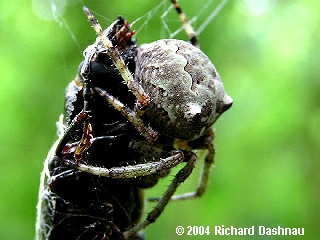 --
--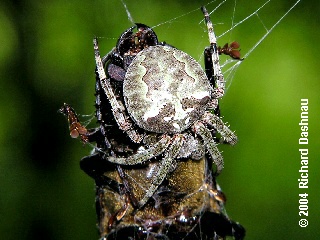 --
--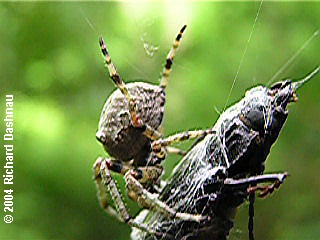
ONE'S A
MEAL
GOOD
EATIN'!
FLASH ON THE
SUBJECT
FROM THE VIDEO CLIP
VIDEO
CLIP 464 kb
Then,
on June 27, two of these spiders appeared at the Visitor's Center.
I took
a picture with a quarter, for scale, and with what is apparently
the egg
case (see FEMALE AND QUARTER, below).
Chuck Duplant pointed out a
male of the same species nearby, and so he got the quarter
treatment, too.
(see MALE AND QUARTER, below) The
last image
is a cropped closeup of the female
(see GIANT LICHEN ORBWEAVER, below).
Many people were calling this a "Marbled Orbweaver" and that's
probably
a reasonable identification for this spider. However....
---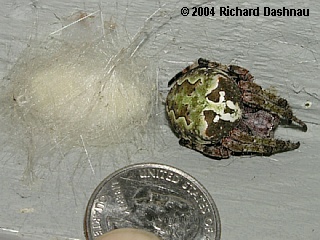 ---
---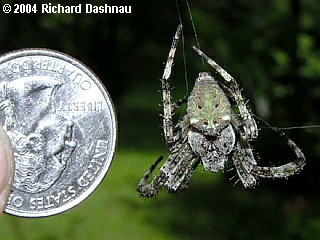 --
--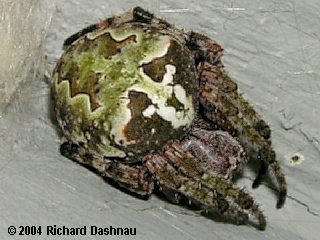
FEMALE AND
QUARTER
MALE AND
QUARTER
GIANT LICHEN ORBWEAVER
I was
looking through my Field Guide to Spiders and Scorpions of Texas
by John
A. Jackman, and there, in the color plates-on P 8, no. 21c at the
bottom
of the page- is a spider that is very close in color
and shape to this
one. Without going into anatomical detail, it is very
difficult to
be sure of the species and genus of many spiders. But, I
looked at
the latin name for this spider in the book,
Araneus bicentarius; and looked
through the few books I have. I couldn't get a good cross
reference, though.
However, I looked on the internet, and found a few good matches,
with pictures
that look very
similar to mine (I find the white Rorschach pattern at the
front of the abdomen quite striking). With some of these pictures
was listed
the common name "Giant Lichen Orbweaver". I think this is a
very
descriptive name, considering the size and greenish (resembling
lichen)
color of the back of the spider. So, that's the identification I
will use
for this spider.
December
18, 2003Today's
RICKUBISCAM story actually took me about 4 weeks to get the
material. It
started when I was looking at an orb web, and saw this string of
egg sacs.
Chuck DuPlant, our volunteer
"spider guy", came by and showed me something
interesting in the web. As the caption in the in the image below
indicates,
things are not what they seem.
---------------------------------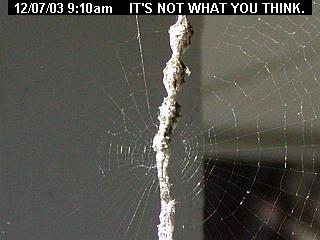
MORE THAN MEETS THE EYE
There's
a string of eggs there, that's for sure. Here's a closer look at
one end
of the string (see NICE EGGS,below). Still can't see
anything?(yeah...I
know, it's only 320 x 240 images, but
there's a lot of them.) Here,
I'm pointing at the very bottom. That's my fingertip off to the
left (see
WEIRD EGG, below). Well, after a slight touch, one of the "egg
sacs" sprouted
LEGS!
(see WHAT THE HECK?, below)
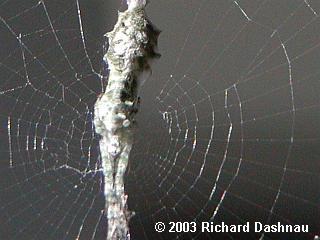 -
-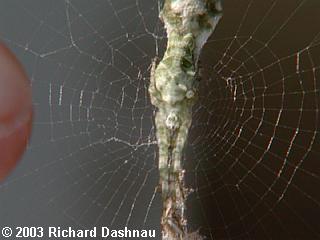 -
-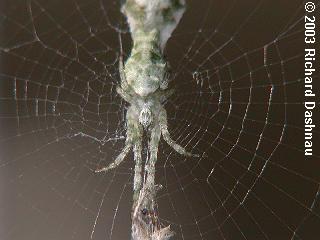 -
-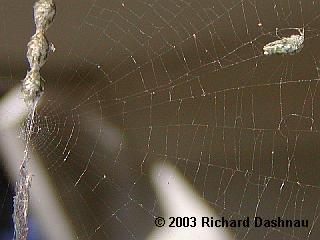 -
-
NICE EGGS!
WEIRD EGG?
WHAT THE HECK?
I'M JUST
JUNK
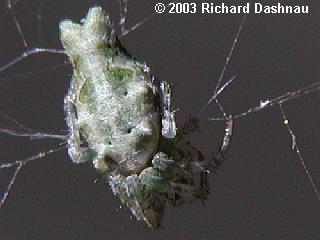
CYCLOSA
A little
more nudging, and the "weird egg" ran off to the side of the web.
It was
a spider! (See I'M JUST JUNK, above). It moved off to the edge of
the web,
and stayed still, acting like a dead
insect, perhaps. This spider,
an orb weaver, is a member of the Cyclosa genus. My "Field Guide
to Spiders
& Scorpions of Texas", by John A. Jackman only lists Cyclosa
Turbinata
in Texas.
There's also a Cyclosa conica (not listed in Texas that I can
find), but I can't find anything to compare the two. In any case,
I'm pretty
sure it's a Cyclosa. The odd-shaped bumps at the end of
the abdomen, and
the large beadlike egg string, and the long stabilimentum also
help identify
this spider. Stabilimenta (plural of "stabilimentum" are the
silken structures
that some spiders
add to their orb webs. The Cyclosa leave remnants of
past meals in theirs (I've seen the name "Trashline Orbweaver"
associated
with this spider elsewhere.) The spider, as you can see, sits
at the end
of its string of egg sacs, and at the top of its
stabilimentum--sort of
at the junction between the two types of "web junk". The marking
on the
egg sacs make them look like a line of
spiders:or, the spider's markings
make it look like a another egg sac, while its legs twine in with
the narrower
tangle.
Isn't
that interesting? After I disturbed it, and it ran to the edge of
the web,
the spider stayed still for a few minutes. Then, it quickly ran
back and
took its place in the center of the web. When I
applied the same stimulus
about 2 weeks later, the same spider didn't run, but instead
simply dropped
straight down, with a safety line. It hung about 2 feet below the
web for
a few moments,
and then climbed back up its safety strand, onto the web,
and back into its camouflage spot. Is that COOL or WHAT?
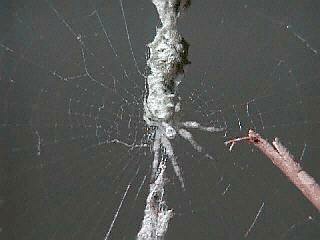 -
-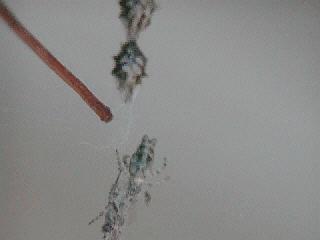 -
-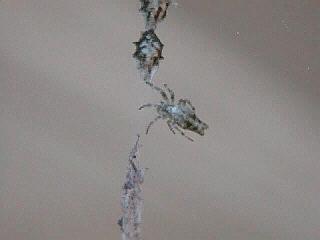 -
-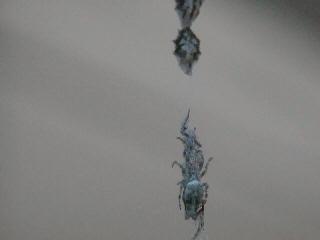 -
-
HELLO?
RUN AWAY!
LET ME BACK IN
CLIMBING
BACK UP
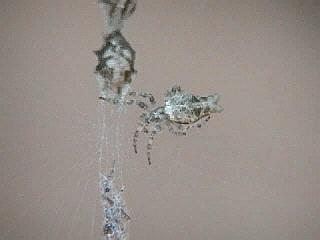
I'M
INVISIBLE!
In case
this is hard to believe, I've got some short video clips of this
spider
doing its trick. The images directly above are single frames from
these
clips. HELLO, above, is from a clip
(flv
video 364kb) of
it "responding" to a gentle probe. RUN AWAY,
above, is from a clip
(flv video
58kb) of the spider deciding to leave. LET ME BACK IN
HERE, above,
is from a clip
(flv video
335kb) of the spider
returning to hide. CLIMBING BACK UP, above,
is from a clip
(flv video
170kb) of the spider returning from its dropping-off ploy.
And finally,
I'M INVISIBLE is from a clip(flv
video
327kb) of the spider moving
back into place...and look how it blends!
The reason that spiders do this kind of thing is still being
discussed.
Some believe that the spider is hiding from predators. Others
believe that
the spider is hiding
itself from potential prey. All I know for sure is
that it surprised me!
November
17, 2003
Now
that we're looking at it, why do spiders' legs curl up like that
when they
die? Well, that's pretty interesting. As in the past, I went to
the book:
Biology
of Spiders, by Rainer F. Foelix, published in 1996
for an answer. Spiders' legs, as I've mentioned before, are
composed
of seven segments. That means that there are six articulations, or
joints
between them (see LEG SEGMENTS, below). For general
body part names,
see BODY PARTS, below. Although I used the Folix book for a
reference
while I made these images, any mistakes
that may be apparent are surely
mine.
-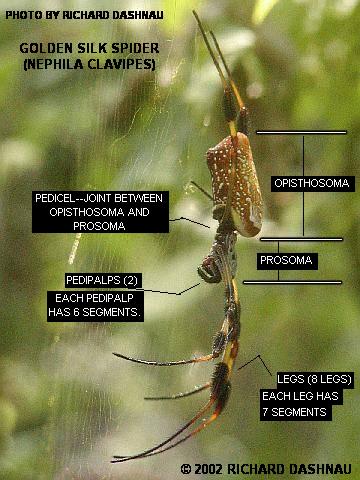 -
-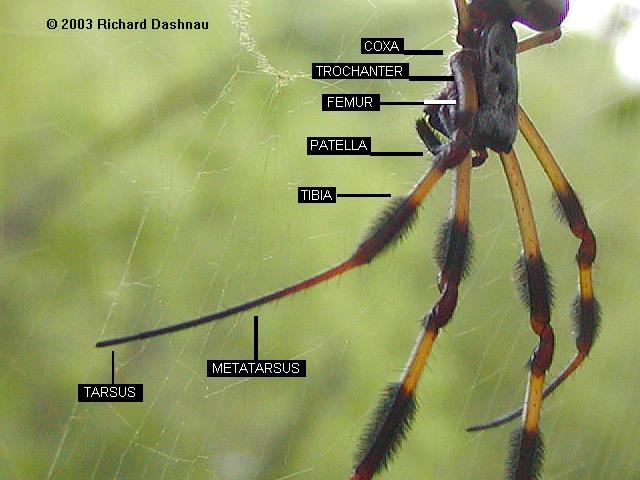 -
-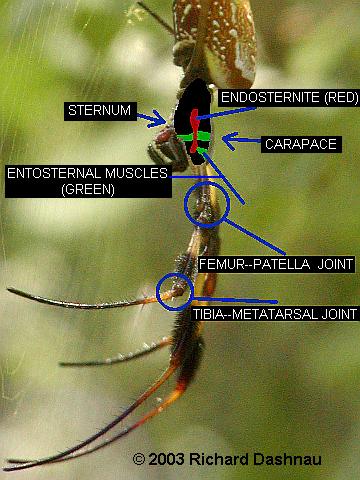
BODY
PARTS
LEG
SEGMENTS
HYDRAULIC PUMP
Now,
most animals have two sets of opposing muscles that operate their
joints.
Flexors, which bend them, and extensors, which straighten them. In
the
spider leg, with six joints, there are two joints which
do NOT have extensor
muscles (from the tip of the leg, this is joint number 2, and
joint number
4. see HYDRAULIC PUMP, above). That means that there are no
muscles to
straighten those joints! How then,
can the spider straighten its legs?
While
you take a moment to wonder about that, consider that spiders not
only
possess an exoskeleton (the "armor"), but they also have a sort of
endoskeleton,
or inner
structural supports as well. They are called "endosterna". These
serve as attachment points for certain muscle groups (entosternal
muscles).
Largest
of the structures of this endoskeleton is shallow cuplike
construction
that sort of bisects the cephalothorax (prosoma) horizontally.
This is
called the "endosternite". There are groups of muscles that
attach this
structure to the carapace (upper surface) and sternum (lower
surface)
of the prosoma. The picture I made above shows these in VERY
simplified
form. If you are interested, find the book and look
at the professional
version. These muscles can move the endosternite, which can
lower
the volume inside the cephalothorax. Doing this can increase the
fluid
pressure inside the spider. This is similar to
you squeezing a toothpaste
tube which lowers the volume, which increases the pressure, and
forces
the toothpaste out . This increase in fluid pressure
acts like a
hydraulic pump; and this is what extends
the second and fourth leg joints.
Without the pressure the legs will fold, if the muscles contract,
and stay
folded.
While
this seems like an odd arrangement to me, spiders were here long
before
I was, so
glitches in the design must have been worked out by now.
Pretty complicated creatures...these "simple", "primitive"
spiders.
November 16, 2003 (this update added 5/13/2022)Most
orb
weavers build their webs so that they hang vertically. But there's
a small beautiful spider that makes a horizontal orb, leaves an
opening
in the center, and then hangs like a beautiful jewel under that
hole. That is an Orchard Spider (Lecauge venusta). I got
these
pictures in 2002 and 2003. Note that these are
examples
of adults this species. I'd never published any of them
in
my domain before, but an interesting development at Brazos Bend
State
park brought them to mind. So, I'm showing the
pictures here for now. I'll be writing more about the even very
soon.
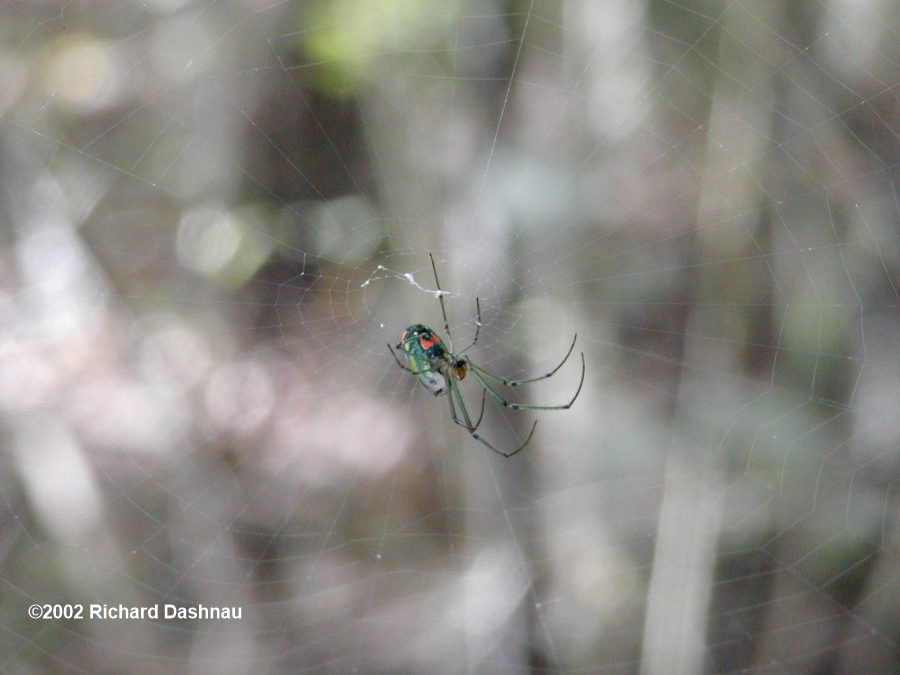 -
-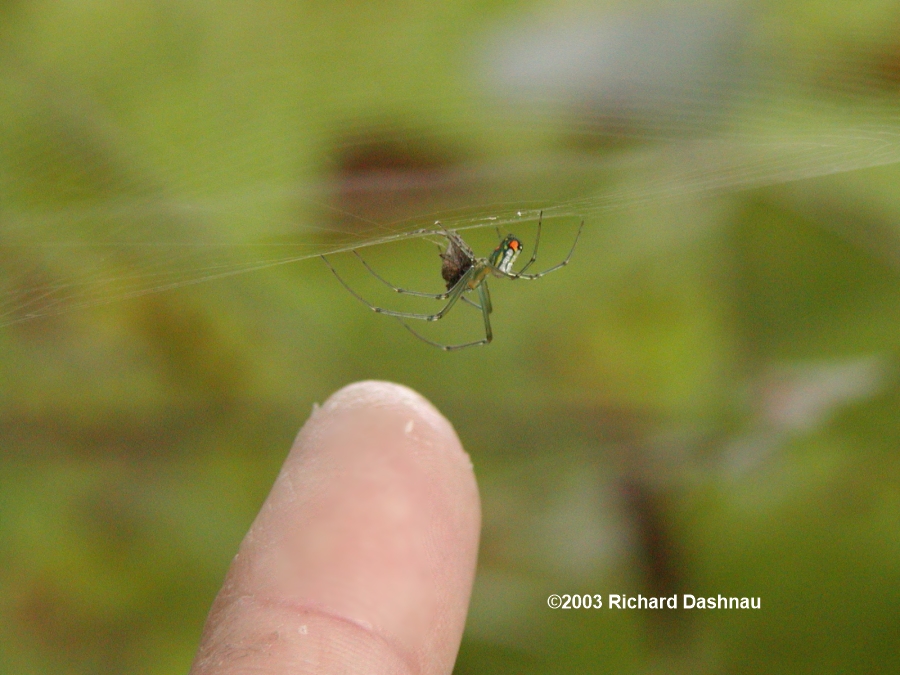 -
-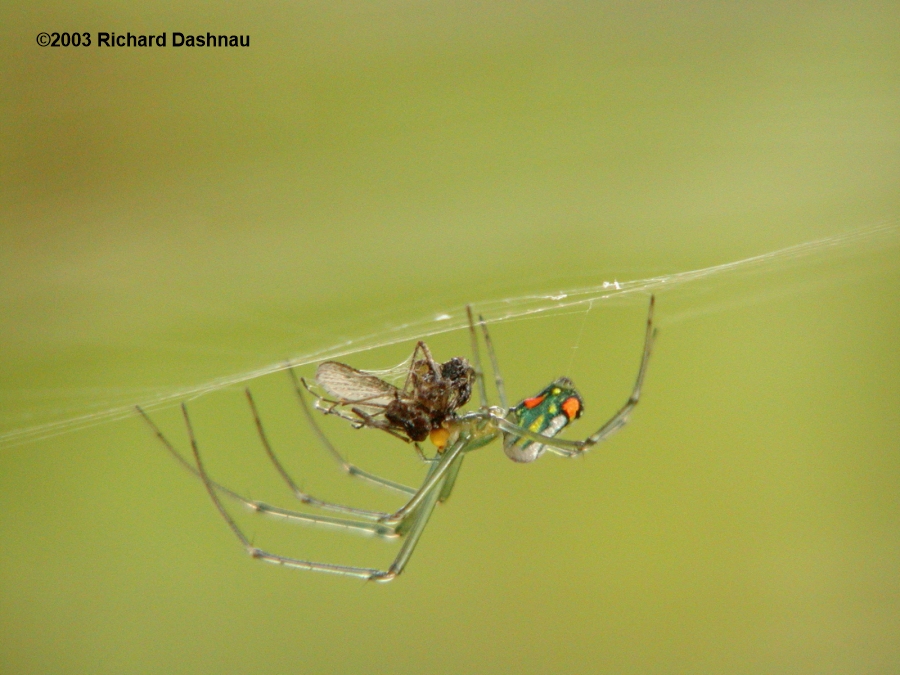 -
-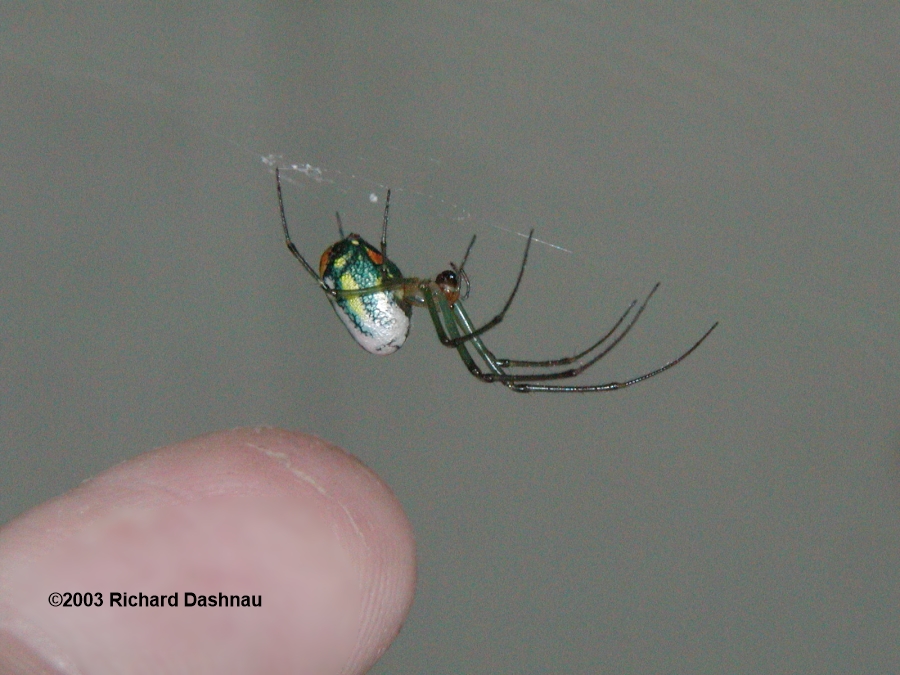 -
-
10/05/2002
10/12/2003
10/12/2003
11/16/2003
October
04, 2003About
50 miles south of Houston is the town of Lake Jackson. While
I was
there, I found a wilderness trail, a small park, and did a
little
exploring. While I was there, I found
some of my arachnid friends, the
Nephila Clavipes. But, as this was about 9:00 am, I was able to
see the
sun shining through a number of other spider webs as well, and
also I found
a lot of
Crablike Spiny Orb Weavers; also known as Gasteracantha
cancriformis.
I've
shown a white one here before, and thought that I'd show that they
vary
in color. So, there's a yellow and a red
one shown here.
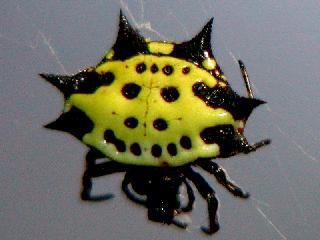 -
-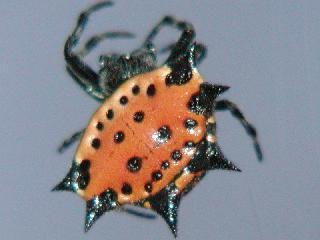 -
-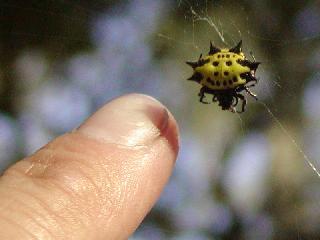 -
-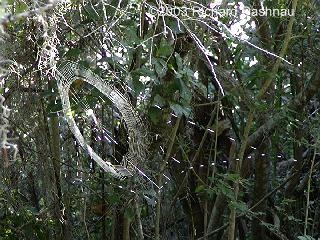 -
-
YELLOW
RED
SPIDER
SIZE
FULL
WEB
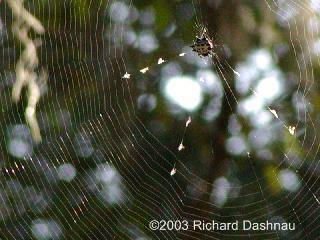
CENTER WEB
These
spiders don't get very big (see SPIDER SIZE, above) as my index
finger
shows. The web is usually marked with tufts of silk, as shown in
the fourth
picture (FULL WEB, above) with the tufts on the
edges of the web. Also
note the circular center web. The other web shows the tufts near
the center
(CENTER WEB, above), and see how there's an open space (no cross
strands)
in the center, where the
spider is? It was nice to enjoy the quieter
pace of Lake Jackson for the day.
August
07, 2003 WHAT ABOUT the
3 pictures
(POKEGAST, below)? As visitors to my pages may have noticed,
I wear
a vest with lots of pockets most of the time (I suppose this is
similar
to
what's known as a "forager's vest"). I have a number of
these
vests, and if one gets wet, or muddy, I immediately change into
another
one. Today, August 10th, I was transferring the contents of
all my pockets
to a clean, dry vest. I'd spent a couple of hours
smashing rice plants
down with the ARGO on Creekfield Lake, and all my clothes had
gotten pretty
wet. As I checked my pockets
one
last time for small items, I found a smallish, pointy lump. I
just
assumed that it was a seed pod or something botanical
that had fallen into my pocket during my rice argoing. When I
tossed it,
I watched out of curiosity as it fell. And then I noticed legs.
So, I picked
it back up, and put it into a small plastic vial that I had
(um...yeah,
in one of my pockets.) Later, at a local Starbucks (where
I
do a
large amount of my page editing, since I use the broadband), I set
up
my little tripod (from another pocket) and my macro slide; and on
one
of their
tables, I took these pictures. This is a
spider commonly known by
the rather ungainly name of "Crablike Spiny Orb-Weaver", and
also known
as Gasteracantha cancriformis. It's rather common at the park, and
I thought
I'd already
showcased this critter on my pages, but I haven't. The web
is orb-shaped, and can be identified by tiny tufts of silk on the
web.
These tufts look something like tiny dustballs stuck to some of
the
strands.
I've photographed these before, but never this closely. The images
below
(CENTERED, and WEAVING) were taken September 01, 2002.
The first
picture shows some of those tufts of
silk. Also, here
(811kb
flv video) is a clip that I took on the same day, of a
Crablike
Spiny Orb-Weaver weaving its orb web. If you look carefully,
you'll see
it touch each support strand with its
spinnarets and string the cross strand.
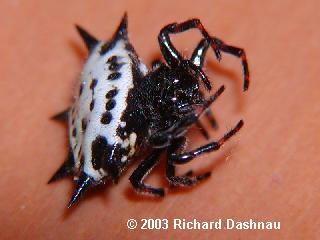 -
- -
-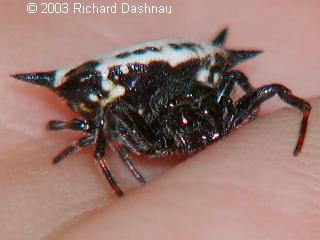 -
-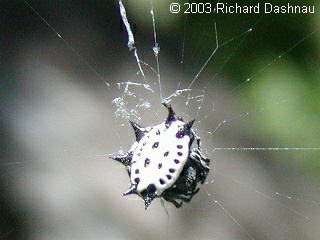 -
-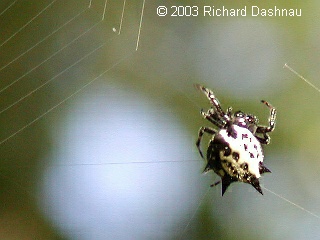
POKEGAST TOP
POKEGAST W/
FINGER
POKEGAST FRONT
CENTERED IN WEB
WEAVING THE ORB
I don't
like moving the animals from where they live, but since this one
had fallen
into my pocket somehow, I already had a subject. The middle image
(W/FINGER)
shows the tip of my index finger
with the gasteracantha. The last image
(FRONT) shows it sitting in the palm of my hand. There's no
telling
how long the poor thing had been in my pocket. I discovered it was
still
alive while I was photographing it, though,
so I released it outside in
some garden plants, and wished it well.
April
06, 2003I've
been watching the trails for signs of new spiders. Finally,
as the
pictures below (YEP, THAT'S SMALL shows, I found some.
---------------------------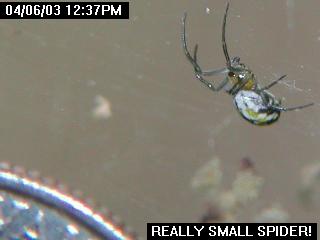 ------------------
---------------
------------------
---------------
YEP, THAT'S SMALL
It was
very difficult to tell what kind they might be. The object in the
lower
left of the picture is a QUARTER! That's right, a 25-cent
piece.
That's a pretty small spider! I hoped that these might
be Golden Silk Spiders
(Nephila Clavipes), but it's too early for those to appear. They
might
be Black and Yellow Argiopes (Argiope Aurantia) though. Here
are
more pictures of them (see
below). There was just no way to tell
what kind of organism the spiders were eating (see WHAT'S IT
EATING, below).
That image also shows the spider's underside. The webs, at first
glance,
seemed to be random collections of strands, but closer inspection
showed
that there were orb webs (about 2 inches across) in amongst the
strands.
I didn't notice any obvious stabilimenta
(those zig-zag patterns that argiopes
make in their webs), either. A comparison of two pictures (WAITING
FOR
FOOD--taken 04/06/2003, and ADULT ARGIOPE--taken 7/14/2002 )
shows
some
possible resemblance in the color patterns, but the physiological
details
are just too small to see and compare.
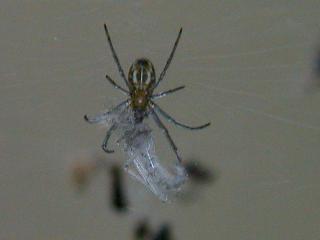 -
-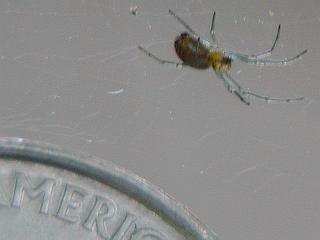 -
-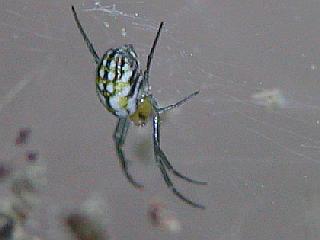 -
-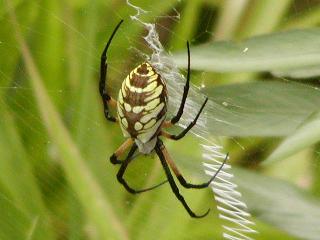 -
-
WHAT'S
IT EATING?
DON'T NEED MONEY!
WAITING FOR FOOD
ADULT
ARGIOPE
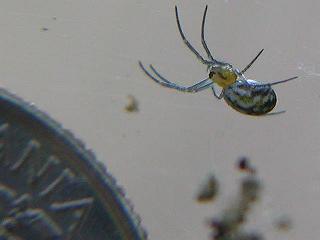
QUARTERBACK
Why don't
spiders get stuck on their own web when they walk on it?
Spiders
have 8 "walking legs". These each have 7 segments. The picture
below (BIG
TROUBLE) shows the last of these segments, the tarsus. (in order
from the
outer end, the segments are:
tarsus, metatarsus, tibia, patella, femur,
trochanter, and coxa; click on the LEG SECTIONS image below to see
640
x 480 image). All spiders have claws (two or three) at the end of
the outermost
segment (see CLAWS FROM THE SIDE, below). The Nephila Clavipes
(and other
spiders who hunt by using a hanging web), uses an interesting
method to
walk on its web. The two "main claws"
(which have serrations on them) are
not used for this at all (see CLAW FROM UNDER). Instead,
there is a smaller,
smooth claw between these two larger hooks. Look closely at the
first two
pictures, and the RICKUBISCAM, and you'll see that the large claws
are
not holding the web at all.
-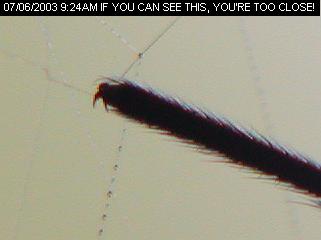 -
- -
-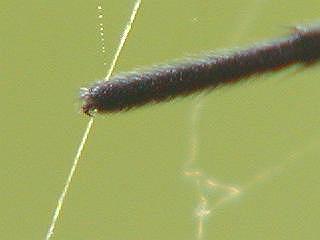 --
--
BIG TROUBLE
LEG
SECTIONS
CLAW FROM THE SIDE
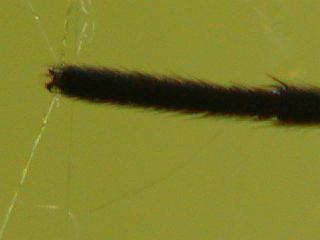
CLAW FROM
UNDER
This
claw can fold in and back out. There are also two stiff hairs
alongside
this claw. The spider, when it wants to grasp its web, puts the
web between
the folding claw and the two hairs, so the
hairs are on one side of the
web, and the claw is on the other. The claw then folds in, and
presses
the strand of web against the two hairs. This pressure slightly
bends the
web across the hairs,
and allows the spider to hold onto it. To release,
the spider relaxes the muscles which pull the hook, and the web
springs
back out. The next time you see a spider walking its web, note how
only
the very tips of its legs touch the web.
As I've
noted before, I've used: The Biology of Spiders, by Rainer F.
Foelix, published
in 1996, as a reference.
March
16, 2003Okay.
I'm sure that repeat visitors to the RICKUBISCAM are wondering:
"Rick?
What about the SPIDERS?"
Well.
For one thing, it's still actually winter. But, here on the
RICKUBISCAM
page, that doesn't matter. Last Wednesday, I noticed something
that was
apparently floating above my dining room
table. Closer inspection
showed it to be a spider--in a web! (See 8- LEGGED WINTER
VISITOR,
below). Well, of course I had to take a few pictures. After
all,
it's not every day that an orb
web appears over your table. My visitor
appears to be a "Garden", or "Cross" Spider. (Araneus
diadematus.)
While I was looking at the spider, it started moving around the
web (see
WEBWALKING, below). Meanwhile, I was trying to focus on it,
so I
could use the picture to identify it (see ANOTHER SHOT,
below). Identification
was difficult, since the spider's markings
and appearance were hard to
see. Why? Well, the last picture (RICK AND THE VISITOR, below)
shows the
tip of my index finger with the spider, for scale. Kind of
difficult to
see, wouldn't you
agree? Since this photo session, the spider has
moved on.
----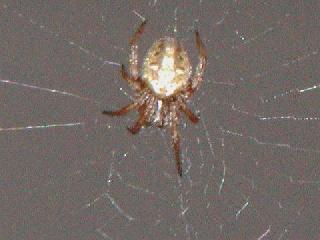 --
--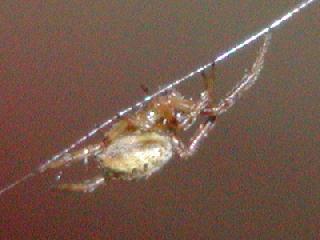 -
-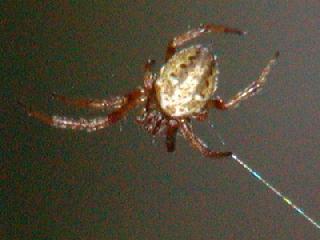 -
-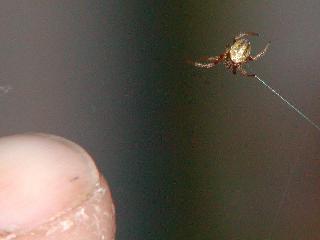 -
-
8-LEGGED
WINTER VISITOR
WEBWALKING
ANOTHER
SHOT
RICK AND THE VISITOR
If you'd like to
know more about the park follow these links:
Brazos
Bend State Park
The main page.
Brazos
Bend State Park Volunteer's Page
The
volunteer's main page.
Click
on this image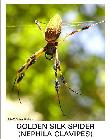 to see a flv video movie (942kb) of a series of 9 11 x 14
posters
I'm working on.
to see a flv video movie (942kb) of a series of 9 11 x 14
posters
I'm working on.
Go
back to my home page, Welcome
to rickubis.com
Go
back
to the RICKUBISCAM
page.
Go
back
to the See the
World
page.
























































































